Kaldrananeshreppur 作者: 来源: 发布时间:2021-09-30
一、所属省或是州,具体位置,人口,面积
Kaldrananeshreppur in Strandasýsla extends from Selá in Steingrímsfjörður to the south to Spena north of Kaldbaksvík. In the district is the village Drangsnes on Selströnd north of Steingrímsfjörður. There is also some settlement in Bjarnarfjörður between Steingrímsfjörður and Kaldbaksvík. It is located in the Westfjords Region in the Northwest Constituency. It has a total population of 109 as of 2020 and is the 65th largest municipality in Iceland by population. It has a total area of 458.9 square kilometers and is the 40th largest municipality by area.
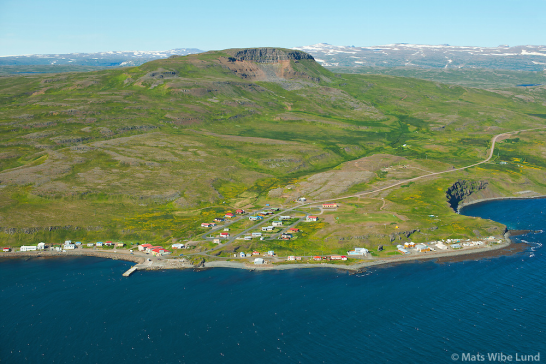
二、自然地理
1.地理条件
In Strandasýsla the former county, there are four municipalities (from south to north):
Húnaþing vestra (partly), Strandabyggð, Kaldrananeshreppur, and Árneshreppur. There are three main villages in the county (from south to north): Borðeyri (27 inhabitants), Hólmavík (385 inhabitants), Drangsnes (65 inhabitants).
Strandasýsla is in the Westfjords and extends from Holtavörðuheiði in the south to Geirólfsgnúpur in the north. The population of the county was 747 at the end of 2008. Strandir is the name of the settlement and the area that lies north along the western side of Hrútafjörður and Húnaflói until Hornstrandir takes over.
On the west side, Strandasýsla borders Norður-Ísafjarðarsýsla, Austur-Barðastrandarsýsla and Dalasýsla. On the east side are Húnaflói and Vestur-Húnavatnssýsla. The southern end of the county stretches up to Holtavörðuheiði where it meets the county boundaries of Mýrasýsla.
The largest urban area in Strandarýsla is the village Hólmavík by Steingrímsfjörður in the middle of Strandir with 368 inhabitants (1 Jan. 2009). This includes shrimp processing and some fishing. Another urban center on the north side of Steingrímsfjörður is Drangsnes and by Hrútafjörður is Borðeyri. In Steingrímsfjörður, outside Drangsnes, is the island Grímsey. Akvegur gets all cars to Ingólfsfjörður, north of Trékyllisvík, but the jeep road reaches all the way to Ófeigsfjörður.
Drangsnes is a small village on Selströnd at the northern end of Steingrímsfjörður in Kaldrananeshreppur in Strandasýsla. The population was 83 in 2015.
In Hveravík, just inside the village, there are hot springs on the beach right by the roadside. Special heat-resistant fleas live there. There used to be a swimming pool. Nearby is Strákatangi, where work began in the autumn of 2005 on an archeological excavation at the Basque whaling station from the 17th century.
Drangsnes has a landing pier, but 2.5 km inside the village, in Kokkálsvík, is a mooring harbor. At the far end of the village, where Grundir is named, is a peculiar rock called Kerling. The village derives its name from this drang, but legend has it that he was one of three trolls who tried to dig the Westfjords from the mainland.
Above the village is Bæjarfell (344 m). From there it is panoramic and there is a comfortable hiking trail on the cliff.
At the mouth of Steingrímsfjörður outside Drangsnes is Grímsey, a true natural pearl. There is a large puffin settlement. There is only a 10 minute cruise to the island and there are trips to Grímsey in the summer with the boat Sundhana, which also offers angling.
In 1996, hot water was found during drilling in the center of the village and district heating was installed in all houses. In the beach below the village there are hot tubs, which everyone is free to use, toilets and changing rooms were opened in the summer of 2011 and they are located on the other side of the street. In the summer of 2005, the swimming pool in Drangsnes was opened, but it is an outdoor pool with a wading pool, hot tub and steam room.
2.交通情况
South of Strandasýsla, Hringvegurinn lies from the county boundary at Mýrasýsla to the bottom of Hrútafjörður. At the bottom of Hrútafjörður are the intersections of it and Innstrandavegur, which runs north along the west side of Hrútafjörður, through Bitter and Kollafjörður and into Steingrímsfjörður on the west side. In the autumn of 2009, a new year-round road opened through Gautsdalur by Króksfjörður and Arnkötludalur to Steingrímsfjörður in Ströndur. He shortened the route from the southwestern corner of the country to Hólmavík and in the northern part of the Westfjords by 40 kilometers. It is part of Djúpvegur, which runs past Hólmavík, over Steingrímsfjarðarheiði and aroundÍsafjarðardjúp, all the way to Bolungarvík. At the bottom of Steingrímsfjörður, it is also possible to turn north of Strandir via Strandavegur north to Bjarnarfjörður, Reykjarfjörður, Norðurfjörður and Ingólfsfjörður.
There are several more short roads in Strandasýsla, such as into Miðdalur in Steingrímsfjörður, into Selárdalur in Steingrímsfjörður and into Sunndalur and Goðdalur in Bjarnarfjörður. In addition, there are almost 30 km of Snæfjallastrandarvegur into Langadalsströnd by Djúp to Kaldalón in Strandabyggð.
三、经济发展和规模
Fishing and sheepherding are some of the main economic activities in the area. The municipality also has a large hotel called Hotel Laugarhóll which is a small guesthouse which generates some tourism revenue for the municipality.
Drangsnes is a young village where urbanization did not begin to form until around 1925. Fishing is the main occupation of the inhabitants and grayling fishing has deep roots there. In fact, the harbor facilities in the village itself are not very good, but a little bit inside the village has been made another harbor in the so-called Kokkálsvík.
Herring fishing had a great impact on settlements in Strandir in the 20th century and factory villages were built around herring fishing, herring salting and smelting in Ingólfsfjörður and Djúpavík . The first "herring adventure" took place when companies were built around herring salting in the years 1917–1919, but they went head to head during the world crisis. The second herring adventure took place in Djúpavík and lasted from 1934 to 1954. The largest herring factory in the country was built there in a very short time and the population of the village was around 500 at its peak. The business flourished until 1944 but declined thereafter. The herring smelter and the factory's operations were then stopped when the herring disappeared from Húnaflói and the village gradually became deserted. Since 1985, one family has lived there and run a guesthouse in the deserted village. After the end of the herring years, the number of people in Árneshreppur, which is now the smallest municipality in Iceland with only one tenth of the population that lived there around the turn of the century in 1900, also began to decrease significantly.
There was a large increase in population in Hólmavík and Drangsnes until the middle of the 20th century, as in many other places due to increased work in the fishing industry. The largest population was around 2100 in the entire county in 1940. A long-term catch shortage from the middle of the century caused some population decline, but again began to increase somewhat when shrimp fishing began in Húnaflói around 1970 and shrimp processing was set up in Hólmavík. After 1990, the population has decreased significantly.
No information on Kaldrananeshreppur’s recent financial statistics or annual financial reports (besides construction and long-term planning) are listed on the municipality website.
四、产业特点重点项目
This is a list of the main construction and development plans proposed by municipality administration for the period of 20 years between 2010-2030.
Proposals for the zoning of seven areas called -A, B, C, D, E, F and G-, Drangsnes, Kaldrananeshreppur. The district committee of Kaldrananeshreppur agreed on 23 September 2014 to advertise proposals for the zoning of seven areas according to Paragraph 1 Article 41 of the Planning Act no. 123/2010 and the reports of the General Plan of Kaldrananeshreppur 2010-2030 (environmental report). These local planning proposals are in all respects based on the Kaldrananeshreppur Master Plan 2010-2030. The local planning proposals cover the entire urban area of Drangsnes as well as the harbor area in Kokkálsvík. The planning areas are delimited as follows and the content (description) of the proposals is as follows:
Area A: Southwestern part of Drangsness, Aðalgata. It envisages one new building on an industrial site. Emphasis is placed on traffic (walking and driving) and parking.
Area B: Northwestern part of Drangsness. Highway no. 645, Kvíabali, a small part of Borgargata and Holtagata. There are plans for two new villas, one semi-detached house and car storage. Emphasis is placed on hiking trails and green areas.
Area C: West part of Grundargata. It is expected that there will be two new detached houses and one semi-detached house. An open green area is defined around Kerlingun. Emphasis is placed on hiking trails and other traffic.
Area D: East of Grundargata. It assumes two new business buildings and one closed outdoor warehouse. Terrace area and a new road to them. Emphasis is placed on hiking trails and traffic.
Area E: Northwestern part of Drangsness. There are plans for five new villas. New road, Vitavegur. Sports facilities and facilities are within the area.
Area F. Northeastern part of Drangsness. There are 11 detached houses and a road here called Tófuhjall. The campsite is demarcated, there are also facilities.
Area G. The harbor area in Kokkálsvík. There are seven plots, three closest to the harbor and four larger plots, which are defined as industrial plots.
http://www.drangsnes.is/stjornsyslan/164-tilloegur-adh-deiliskipulagi
The largest guest house in the area is the Hótel Laugarhóll, located in Bjarnarfirði.
五、风景名胜,景点( attractions)
1. Grímsey (Steingrímsfjörður)
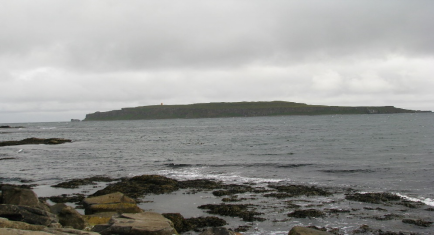
Grímsey in Steingrímsfjörður is the largest island off the coast. It is 773 hectares in size. Grímsey used to be a farm and until the 20th century, people spent the winter on the island and lived in tents. At the beginning of the 20th century, foxes were hunted on the island and then hunted when the fur was most abundant. A lighthouse was built on the island in 1915 and then rebuilt in 1949, after the Germans had destroyed it with a bombing raid during World War II.
Grímsey has a huge settlement of puffins. It is estimated that there are between 25-30 thousand pairs of puffins. From Drangsnes there are scheduled trips to Grímsey during the summer. It is just about a 10 minute cruise.
In Landnámabók, Grímsey is said to have been named after Grímur Ingjaldsson Hróaldsson from Haddingjadalur, who spent the winter there and drowned while rowing during the winter.
The motorboat Hrefna II from Hólmavík found a 400 kg 157 cm long sea turtle on the island in 1963 and it is the only example that a turtle was found naturally near Iceland.
2. Gvendarlaug in Bjarnarfjörður
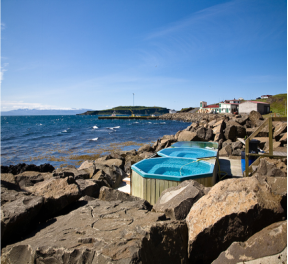
Gvendarbrunnar Pool Bjarnarfjordur the beaches is a small charge bathing pool about 100 meters north west corner Pool endoscope in the old schoolhouse on Kluk. The pool is protected as an archaeological site and is one of many Gvendarlaugar in Iceland, where it is said that Guðmundur góði Arason, bishop of Hólar (-1237), consecrated the lake.
A little below the swimming pool, between Hotel Laugarhóll and Kotbýli kuklarans which is part of the Magic Show in Strandir, is a swimming pool which is also called Gvendarlaug, after the old pool.
3.Bæjarfell Mountain
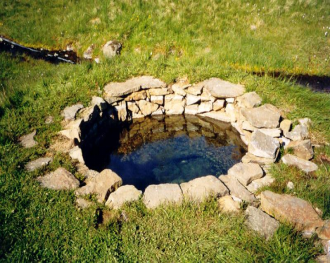
In the vicinity of Drangsnes there are many beautiful hiking trails. Hiking up to Bæjarfell is suitable for the whole family and from the mountain there is a beautiful view out to Steingrímsfjörður, Húnaflói and to Grímsey.
https://www.westfjords.is/is/westfjords/town/drangsnes
六、历史文化
1.历史
In the Settlement, only sixteen settlers in Strandir are mentioned. The main ones are Þorvaldur Ásvaldsson, father of Eiríkur rauða who took land in Drangar, Önundur tréfótur who took land in Kaldbaksvík, Björn the one whose name is Bjarnarfjörður, Svan's father in Svanshóll and Hallgerður langbrókur's maternal grandfather, and Steingrímur trölli who took land in Steingrímsfjörður and lived in Troll tongue. Strandir did not have a special parliament, but Strandamenn attendedÞorskafjarðarþing in Barðastrandarsýsla.
Strandir is mentioned in Icelandic sagas such as Njála, Þorgils saga and Hafliði and Eyrbyggja. There are several legends about Guðmundur, a good bishop in Strandir, but he will have become a shipwreck in Skjaldabjarnarvík in 1180 and later in life fled to Strandir from his persecutors. In Sturlunga tells the story of how Þórður Kakali built his ships at Árnesey in Trékyllisvík and planned to keep them in Eyjafjörður but instead came to the fleet of young Kolbeinn in Flóabardaga in Húnaflói.
Strandasýsla is first mentioned in sources from 1553. In ancient times it was known that it was called Balasýsla.
Drangsnes takes its name from a large cliff that stands in the village. Legend has it that one of the trolls who once tried to dig the Westfjords free from Iceland has arrived there, but dawned and turned to stones before they were able to complete the work. The island of Grímsey, which is close to land, is also the result of this trolls' improvement project. There is a rich bird life with a large puffin population that is popular with tourists. Scheduled sailings to the island from Drangsnes have started and the voyage only takes about 10 minutes.
https://www.westfjords.is/is/westfjords/town/drangsnes
2. 文化体育
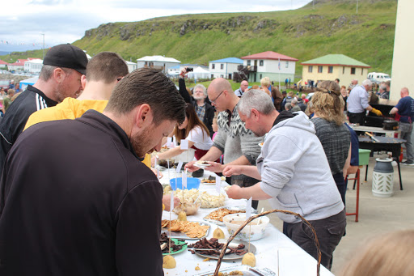
The town of Drangsnes holds the Pier Festival Annually, which celebrates the culture and local people. The festival often has an attendance of around 100 people which is quite large considering the towns population is even smaller than 100.
The program of the festival is great and has been of a similar format from the beginning. The seafood tasting is wildly popular, boat trips to Grímsey, a history exhibition about the hot water on Drangsnes, a coffee buffet, a football game between Hólmavík and Drangsness, Bryggjó got talent competition, hill singing and dancing in the evening.
http://www.bb.is/2019/10/drangsnes-bryggjuhatid-a-naesta-ari/
七、其他信息
On Thursday, September 3, 2020, the local government of Kaldrananeshreppur met for the 24th meeting of the election period at the district's office in the meeting house Baldur in Drangsnes.
The meeting was attended by Finnur Ólafsson, Eva K. Reynisdóttir, Arnlín Óladóttir, Kristín Einarsdóttir and Ingi Vífill Ingimarsson. Margrét Bjarnadóttir and Halldór Logi Friðgeirsson announced their absence. Oddviti called a meeting at 20:00. Eva Katrín Reynisdóttir writes the minutes on a computer.
https://www.drangsnes.is/414-sveitrarstjornarfundur-var-haldinn-3-september-2020
八、联系方式
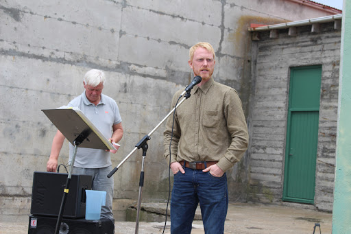
Mayor (Odvitti): Finnur Ólafsson
Telephone: 451 3277
Email: oddviti@drangsnes.is
https://www.drangsnes.is/a
